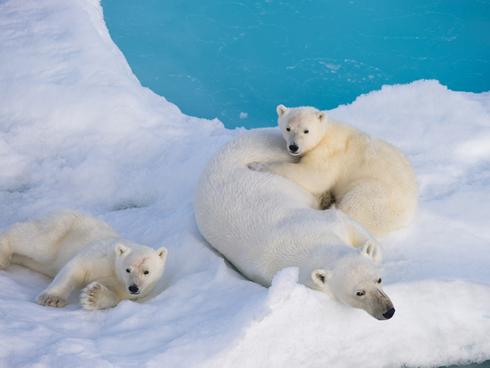Polar bears split from ancient bears more than 4 million years ago, suggests ancient DNA and the gene maps of multiple bears.

The polar bear genome finding reported in the Proceedings of the National Academy of Sciences journal contradicts earlier gene studies finding much more recent times for the ancestral split, within 600,000 years, between polar bears and grizzly bears, which can still mate and produce viable offspring.
What’s more, the report suggests that polar bear numbers have been on the decline for at least 500,000 years, driven by climate fluctuations.
“Although polar bears ( Ursus maritimus) and brown bears (Ursus arctos) are considered separate species, analyses of fossil evidence and mitochondrial sequence data have indicated a recent divergence of polar bears from within brown bears,” begins the study led by Penn State’s Webb Miller:
“A whole-genome analysis of the polar bear may provide a more complete picture of its evolutionary history, possible signatures of admixture, and clues about the genetic basis of adaptive phenotypic features facilitating life in the Arctic, all of which are imperative for gaining a better understanding of possible responses to current and future climatic changes,” says the study.
Looking at blood and tissue one American black bear, one brown bear from the Kenai Peninsula, two brown bears from Alaska’s Alexander Archipelago, five polar bears from Alaska, and 18 polar bears from Norway, as well as tissues from a 120,000 year-old fossil polar bear skull, the team performed a “deep genome” analysis to compare DNA across bear species. Although mitochondrial DNA suggests a split between grizzlies and polar bears as recently as 152,000 years ago, full genome data tells a different story, finds the study.
Overall, a split between the ancestors of grizzlies and polar bears look most likely from 4 to 5 million years ago, the study concludes, during an era that saw splits in other bear lineages and the start of sea ice covering the Arctic. Episodes of hybridization between polar and brown bears likely explain earlier gene study results showing a more recent origin for polar bears. These past kinks in polar bear DNA seem tied to past natural climate warming episodes limiting polar bear populations to icy preserves in places such as Norway.
The results paint a dour picture for the continuation of polar bears as a species, where the study notes, “the current trend toward an increasingly warmer climate in the Arctic has caused sea ice to retreat dramatically and possibly at a pace never experienced before. If this trend continues, it is possible that future PBs throughout most of their range may be forced to spend increasingly more time on land, perhaps even during the breeding season, and therefore come into contact with brown bears more frequently.”





